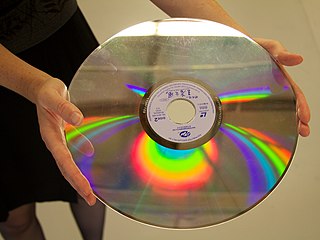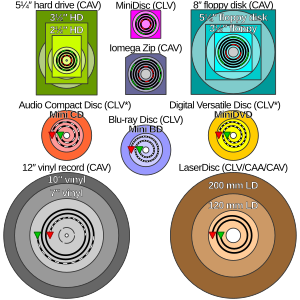
The compact disc (CD) is a digital optical disc data storage format that was co-developed by Philips and Sony to store and play digital audio recordings. In August 1982, the first compact disc was manufactured. It was then released in October 1982 in Japan and branded as Digital Audio Compact Disc.

CD-R is a digital optical disc storage format. A CD-R disc is a compact disc that can be written once and read arbitrarily many times.

Disk storage is a general category of storage mechanisms where data is recorded by various electronic, magnetic, optical, or mechanical changes to a surface layer of one or more rotating disks. A disk drive is a device implementing such a storage mechanism. Notable types are today's hard disk drives (HDD) containing one or more non-removable rigid platters, the floppy disk drive (FDD) and its removable floppy disk, and various optical disc drives (ODD) and associated optical disc media.

An optical disc is a flat, usually disc-shaped object that stores information in the form of physical variations on its surface that can be read with the aid of a beam of light. Optical discs can be reflective, where the light source and detector are on the same side of the disc, or transmissive, where light shines through the disc to be detected on the other side.

The LaserDisc (LD) is a home video format and the first commercial optical disc storage medium, initially licensed, sold and marketed as MCA DiscoVision in the United States in 1978. Its diameter typically spans 30 cm (12 in). Unlike most optical-disc standards, LaserDisc is not fully digital, and instead requires the use of analog video signals.

In computing, an optical disc drive is a disc drive that uses laser light or electromagnetic waves within or near the visible light spectrum as part of the process of reading or writing data to or from optical discs. Some drives can only read from certain discs, but recent drives can both read and record, also called burners or writers. Compact discs, DVDs, and Blu-ray discs are common types of optical media which can be read and recorded by such drives.

DVD-RAM is a DVD-based disc specification presented in 1996 by the DVD Forum, which specifies rewritable DVD-RAM media and the appropriate DVD writers. DVD-RAM media have been used in computers as well as camcorders and personal video recorders since 1998.

In optical storage, constant angular velocity (CAV) is a qualifier for the rated speed of any disc containing information, and may also be applied to the writing speed of recordable discs. A drive or disc operating in CAV mode maintains a constant angular velocity, contrasted with a constant linear velocity (CLV).

Revolutions per minute is a unit of rotational speed for rotating machines. One revolution per minute is equivalent to 1/60 hertz.

In computer storage, zone bit recording (ZBR) is a method used by disk drives to optimise the tracks for increased data capacity. It does this by placing more sectors per zone on outer tracks than on inner tracks. This contrasts with other approaches, such as constant angular velocity (CAV) -drives, where the number of sectors per track are the same. On a disk consisting of roughly concentric tracks – whether realized as separate circular tracks or as a single spiral track – the physical track length (circumference) is increased as it gets farther from the centre hub.

DVD recordable and DVD rewritable are optical disc recording technologies. Both terms describe DVD optical discs that can be written to by a DVD recorder, whereas only 'rewritable' discs are able to erase and rewrite data. Data is written ('burned') to the disc by a laser, rather than the data being 'pressed' onto the disc during manufacture, like a DVD-ROM. Pressing is used in mass production, primarily for the distribution of home video.

Optical disc authoring requires a number of different optical disc recorder technologies working in tandem, from the optical disc media to the firmware to the control electronics of the optical disc drive.

CD-RW is a digital optical disc storage format introduced in 1997. A CD-RW compact disc (CD-RWs) can be written, read, erased, and re-written.

Ultra Density Optical (UDO) is an optical disc format designed for high-density storage of high-definition video and data. The format was introduced by Sony to replace the Magneto-optical disc format.

The DVD is a digital optical disc data storage format. It was invented and developed in 1995 and first released on November 1, 1996, in Japan. The medium can store any kind of digital data and has been widely used for video programs or formerly for storing software and other computer files as well. DVDs offer significantly higher storage capacity than compact discs (CD) while having the same dimensions. A standard single-layer DVD can store up to 4.7 GB of data, a dual-layer DVD up to 8.5 GB. Variants can store up to a maximum of 17.08 GB.
In the history of optical storage media there have been and there are different optical disc formats with different data writing/reading speeds.

Toshiba Samsung Storage Technology Corporation is an international joint venture company of Toshiba (Japan) and Samsung Electronics. Toshiba used to own 51% of its stock, while Samsung used to own the remaining 49%. The company specialized in optical disc drive manufacturing. The company was established in 2004.

A CD-ROM is a type of read-only memory consisting of a pre-pressed optical compact disc that contains data. Computers can read—but not write or erase—CD-ROMs. Some CDs, called enhanced CDs, hold both computer data and audio with the latter capable of being played on a CD player, while data is only usable on a computer.
Higher performance in hard disk drives comes from devices which have better performance characteristics. These performance characteristics can be grouped into two categories: access time and data transfer time.

LV-ROM is an optical disc format developed by Philips Electronics to integrate analog video and computer software for interactive multimedia. The LV-ROM is a specialized variation of the CAV Laserdisc. LV-ROM is an initialism for "LaserVision Read-Only Memory".















